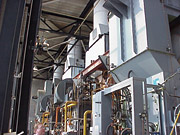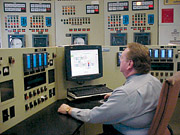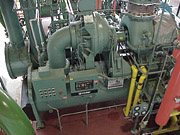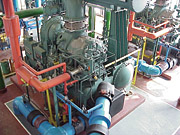

Not only did the airport lack consistent comfort levels, but its old chillers and inefficient boilers led to sky-high utility bills. Something had to be done. The Wayne County Airport Authority (WCAA) wanted to provide improvements that would be flexible enough to deliver world-class comfort and safety in future configurations. It also wanted to cut the airport's energy bills by 20% to 25%. This had to be accomplished by updating the airport's mechanical, electrical, and lighting systems.
But there was no money to fund the enormous renovation project. The fact remained, though, that much of the HVAC equipment was failing and needed to be replaced. The airport found the solution to its problem through a performance contracting arrangement with Siemens Building Technologies.
The $15 million energy conservation project, which began in September 2001, was finished approximately 18 months later: On time, on budget, and with no changeorders. To date it is estimated that the project has saved the airport $1.8 million in energy costs.

Getting Started
The energy conservation project was initially developed internally, through the airport's power plant department. The power plant oversees the central heating and cooling plants for the airport, and they had been trying to get budget approval for capital expenses for quite some time."We didn't have the capital funds to replace aging equipment, which was getting too expensive to maintain," said Len Cranston, power plant executive. "That's when we decided to try a performance contract or self-funding approach, whereby the cost of the contract is funded by the savings generated from the improvements."
After qualifying and competing for the project, Siemens presented the lowest price with the highest energy savings and won the contract. The scope of Siemens' work included energy efficiency audits of all the facilities, HVAC equipment retrofits and replacements, enhancements to the existing Siemens BAS, and retrofits to brighten lighting. In addition, most of the electrical systems were upgraded to include power monitoring to better manage the airport's electric power usage.

Chillers Get Steamed
One of the airport's big problems was its chilled water system. "We ended up taking out three of their existing 2,000-ton electric chillers, which were about 30 years old," said Peter Gruener, project manager for Siemens Building Technologies in Livonia, MI. "One of the chillers was completely dead." Only one original chiller was left in place: A 1,500-ton electric unit that had been part of a partial retrofit approximately ten years ago.In addition to old chillers, the airport had problems with the distribution network. Part of the problem was due to the ten-year-old retrofit project, which, if finished, was supposed to have updated the chilled water plant.
"They only did the first phase, which was to put in primary/secondary pumping, but they didn't do anything out in the field like replacing three-way valves or correcting their bridge problems," said Greg Warner, P.E., senior energy engineer (now district performance assurance manager) for Siemens Building Technologies.
With the existing chilled water system, the airport was only getting a 3 degree to 5 degree delta T instead of a 10 degree delta T. This led to large energy consumption, because the existing chillers could only load 50% or 60% on a peak day. Consequently, they had to run three 300-hp secondary pumps at 80% or 90% all the time just to keep up with the flow in the system. This meant the power plant had to run two or three chillers at half load just to keep the system under control.
To solve the problem, Warner and his team first identified and replaced all the three-way valves in the system. They also rebalanced some of the nonfunctioning controls in the system. "They were set up for a tertiary loop, but they weren't controlling return water temperatures, so it wasn't getting the load out in the system that we needed. So we redid the controls," noted Warner.
When it came to replacing the chillers, Warner first looked at the energy costs of operating the chiller plant. He found that the chillers alone required 1.1 or 1.2 kW/ton - that and didn't include the power or pumps or any other equipment. Then Warner went through all the chiller logs to figure out the exact amount being pumped through the chiller plant.
As a result, he planned to install steam absorption chillers. "The main reason we wanted to go with steam was to get away from the electric demand charges. The utility here has demand charges of about $20 to $21 per kW, which is pretty hefty. The real savings didn't come from reducing the chilled water load as much as it did by developing it cheaper. My thought was to use the steam from the boilers to generate it," said Warner.
Gruener added, "The airport has four boilers that have a capacity of 45,000 lbs of steam per hour. Basically, in the summer they have a very low load for the boilers, so going to steam was a way to get off the electricity."
But as fate would have it, the manufacturer chosen for the project stopped producing steam absorption chillers. The solution? Two 1,500-ton York Millennium steam turbine-driven centrifugal chillers were installed, as well as one 1,500-ton Millennium electric chiller.
Tim Winn, senior sales engineer for York in Detroit, said that the steam turbine-driven chillers were a great choice for the airport, because they have many advantages over steam absorption chillers. These advantages include competitive price, smaller footprints, and easier maintenance. "What's good news for power plant personnel is that all three chillers at the airport are the same style, so there is a commonality of parts even though one is an electric chiller and two are steam turbine driven chillers. All three chillers also share the same refrigerant," said Winn.
This summer the airport managed to get by without running either of the electric chillers, except for maintenance purposes. Warner noted that they haven't peaked out the two steam turbine-driven chillers yet.

Better Boilers And Controls
The boilers themselves were in pretty good shape and did not need to be replaced. However, two of the four boilers had stack economizers, and two did not. Warner rectified that situation by installing stack economizers on the other two boilers.Leaks in the steam system also constituted a big problem at the boiler plant. Many of the condensate pumps in the system were not returning condensate to the power plant. Instead, the condensate was usually being dumped down the drain or simply not being returned. The existing condensate pumps were repaired or replaced throughout the airport campus to fix the problem.
Another issue at the boiler plant was that old controllers were being used, and it was no longer possible to get replacement parts for them. A new boiler control system, consisting of full PID loop controllers, was installed in order to maintain proper boiler function.
"We also put in new flowmeters on the boilers, so they could actually measure gas flow," said Warner. "The ones they had in there before were not responding very well. When we were all done, we did all the boiler tuning and optimization of the controls."
The boiler controls operate on a ModBus network, and Warner was able to put a gateway into that network to bring boiler information into the airport's existing Siemens System 600 BAS. The old datalogger that was being used didn't log boiler parameters, but the new gateway allowed power plant staff to keep boiler logs, execute boiler efficiency calculations, and perform long-term logging through Siemens' InfoCenter program.
InfoCenter is basically a standalone data management and collection system that operates with the System 600. Numerous types of information, such as stack CO2, burner efficiencies, the amount of gas used, stack temperatures, etc., can now be logged into InfoCenter and archived for historical purposes.
The Rest of the BAS
Using a York gateway into the chillers, the InfoCenter can also log important information on the chillers, such as temperatures, steam usage, and supply and discharge. The steam usage information helps the power plant generate chiller efficiency curves.A gateway was also installed into the existing Westinghouse "PowerNet" network, which monitors all the substations at the airport, as well as the incoming electric supply. "The airport has a separate computer for the boilers and for the chillers, and they have a separate computer to monitor the power system," said Warner. "That is now all being collected into the Siemens System 600, and we're doing the datalogging into the InfoCenter."
The airport was actually in pretty good shape with its existing BAS. That's because over the years, Siemens had kept the system current with different revisions of software. "We didn't have to replace the old system, because it was already current and usable. I think we put in one additional panel in the power plant to interface with the gateways, and we did some upgrades to make the system work better. But we didn't have to go through the wholesale replacement of everything to make it work," said Warner.
Gruener noted that a lot of what had to be done was to interface with the older equipment. "We put new controls on the boilers, so we could get more information from them. We did the same with the electrical distribution system for the whole airport. We also installed controls to give the airport better management reports and tracking of their energy. That's accomplished with InfoCenter and also a program called Utility Cost Manager."
Other Changes
Another part of the renovation involved retrofitting Building 358, which houses the airport police department. That building, which is located on the far side of the airport campus, needed extensive updating.The building, which was constructed in 1949, had one steam boiler that was used for heating. During a later retrofit, rooftop units were added to the building. The two-story building had four rooftop units, which made it difficult to keep the space comfortable.
"We took off the four constant volume rooftop units and put in five smaller rooftops with VAV boxes to zone the building better," said Warner. "We installed a new boiler, changing it from steam to hot water, and we put in hot water radiation." A complete lighting retrofit was also performed and new windows installed. The new boiler and rooftop units are also tied into the System 600.
With the project completed, everyone seems happy. Warner noted that the payback is going very well. "We projected about a ten-year payback, and we're probably running about 10% to 15% ahead of our projected savings. That was based only on energy." He noted that additional savings can be found through reduced replacement parts, although those figures aren't part of the original performance contract.
Airport passengers and employees are happy, too, and the greater comfort from improved temperature control has resulted in a dramatic reduction in time-consuming temperature-related complaint calls. There is also improved safety from more brightly lit parking areas.
So the next time you pass through Detroit Metropolitan Airport, take a few moments to enjoy the improvements. Then realize that your increased levels of comfort and security are saving the airport a bundle in energy costs each year. ES

